Top Content Creation Templates to Boost Your Productivity
Unleash Your Inner Content Creator
Creating engaging content takes time and effort. Streamline your workflow with content creation templates. This list of top tools, including Canva, Adobe Express, Figma Templates, Notion Templates, Visme, Later Influence, VistaCreate (formerly Crello), and Piktochart, provides ready-made frameworks to simplify your content creation process. Discover how these resources can save you time and maintain a consistent brand identity, whether you're crafting social media posts, presentations, or marketing materials. Learn how to leverage content creation templates to enhance your content strategy and boost your online presence.
1. Canva
Canva has quickly become a go-to platform for creating visually appealing content, offering a vast library of content creation templates that cater to a diverse range of needs. From social media graphics and presentations to marketing materials and even videos, Canva empowers users to design professional-looking content without needing advanced design skills. Its user-friendly interface and drag-and-drop functionality make it accessible to beginners, while the extensive template library and customization options provide ample resources for experienced creators. If you're looking for a versatile tool to streamline your content creation process, Canva deserves serious consideration.
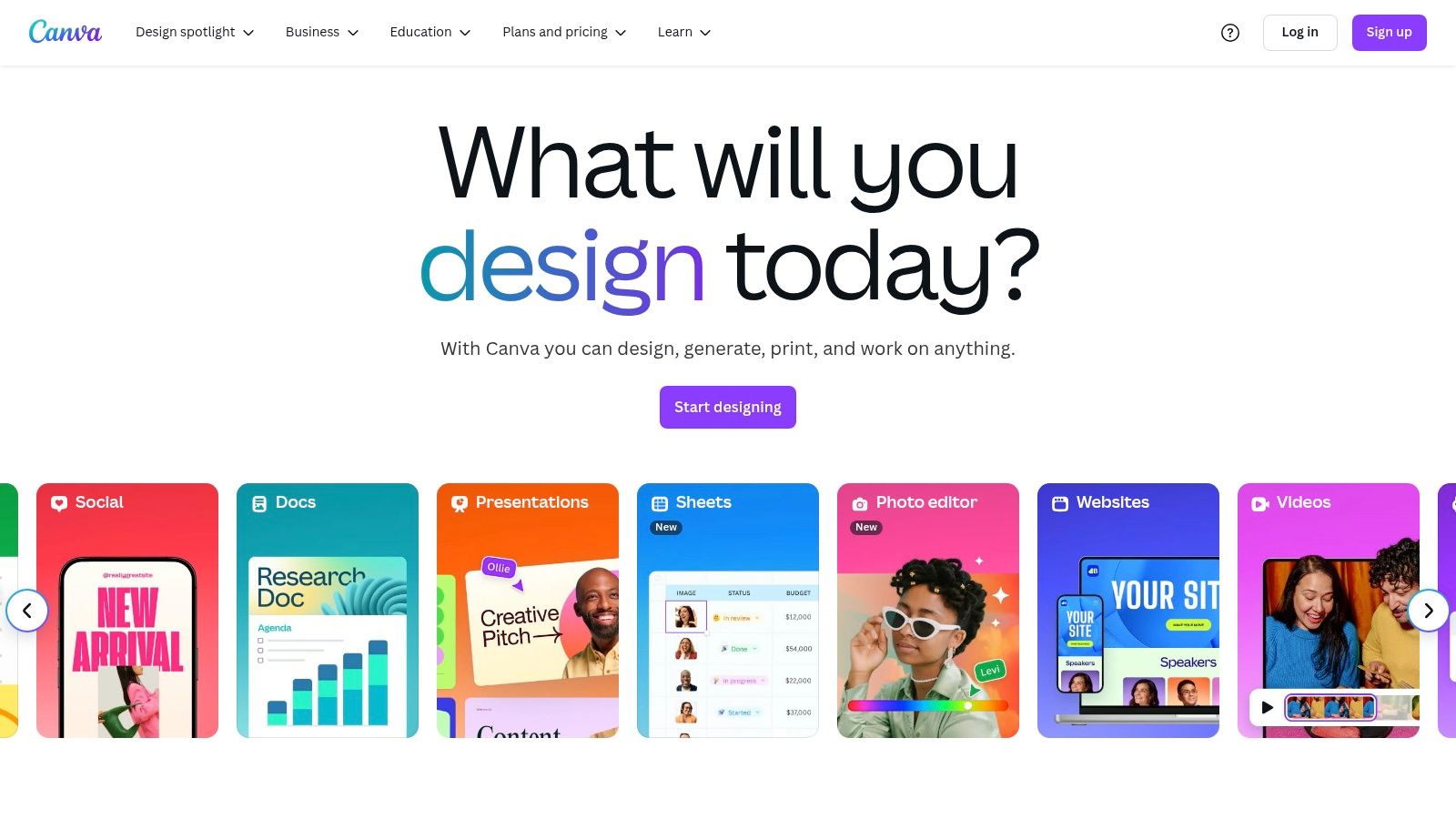
Canva’s true strength lies in its extensive library of over 250,000 free content creation templates, spanning a wide array of content types. Whether you need to design an engaging Instagram post, a professional presentation, an informative infographic, or even a short video, Canva has pre-designed templates ready to be customized. This eliminates the need to start from scratch, saving valuable time and effort. These templates incorporate professional design elements, ensuring your content looks polished and visually appealing, even without prior design experience.
Individual creators and influencers can leverage Canva to create visually consistent content for their social media platforms, building a strong brand identity. Small business owners and entrepreneurs can design marketing materials like brochures, flyers, and social media graphics without hiring a professional designer. Digital marketing agencies can utilize Canva for client projects, creating visually compelling content for various marketing campaigns. Social media managers can streamline their workflow by scheduling and publishing content directly from Canva. Even developers and automation specialists can integrate Canva into their workflows to automate certain content creation tasks.
Canva offers a free tier that provides access to a substantial collection of free content creation templates and design elements. This makes it an excellent starting point for individuals and small businesses with limited budgets. For those needing access to premium features like a larger template library, brand kit functionality, and unlimited storage, Canva offers subscription plans. The Pro plan is designed for individuals and small teams, while the Enterprise plan caters to larger organizations with more advanced collaboration and brand management needs. Pricing details are available on the Canva website.
Canva works seamlessly across multiple platforms, including web browsers, mobile devices (iOS and Android), and even desktop applications. This multi-platform accessibility allows you to create and edit content on the go, ensuring you can maintain a consistent content creation workflow regardless of your location.
Getting started with Canva is straightforward:
- Sign up for a free account: Visit the Canva website (https://www.canva.com) and create a free account using your email or social media login.
- Choose a template: Browse the extensive template library and select a template that aligns with your content needs.
- Customize the template: Use the drag-and-drop editor to modify the template’s text, images, colors, and other design elements. You can also upload your own images and logos.
- Download and share: Once you’re satisfied with your design, download it in various formats (JPEG, PNG, PDF, etc.) or share it directly to your social media platforms.
While Canva is a powerful and versatile tool, it’s important to acknowledge its limitations. The customization options, although extensive, are not as granular as those offered by professional design software like Adobe Photoshop or Illustrator. While the free tier provides a good starting point, some users might find that the premium features locked behind a subscription are essential for their needs, which can become a cost consideration, especially for larger teams. Finally, the popularity of Canva means some templates might look generic due to widespread use. However, with a little creativity and customization, you can still create unique and engaging content using Canva's resources. Compared to other tools like Adobe Spark or Crello, Canva offers a more comprehensive set of features and a wider selection of templates, making it a robust solution for a broader audience. Its intuitive interface and extensive free tier truly set it apart, making it an invaluable tool for anyone looking to create visually compelling content without the steep learning curve associated with more complex design software.
2. Adobe Express
Adobe Express (formerly Adobe Spark) is a powerful content creation platform offering a vast library of professionally designed templates. It's an excellent choice for anyone looking to create visually stunning content quickly, from social media graphics and web pages to short videos and animations. Its integration with Adobe Creative Cloud and AI-powered design suggestions, coupled with access to Adobe Stock assets, makes it a robust solution for both beginners and experienced designers seeking high-quality content creation templates. This tool earns its place on this list due to its versatility, professional design capabilities, and the seamless integration with the broader Adobe ecosystem.
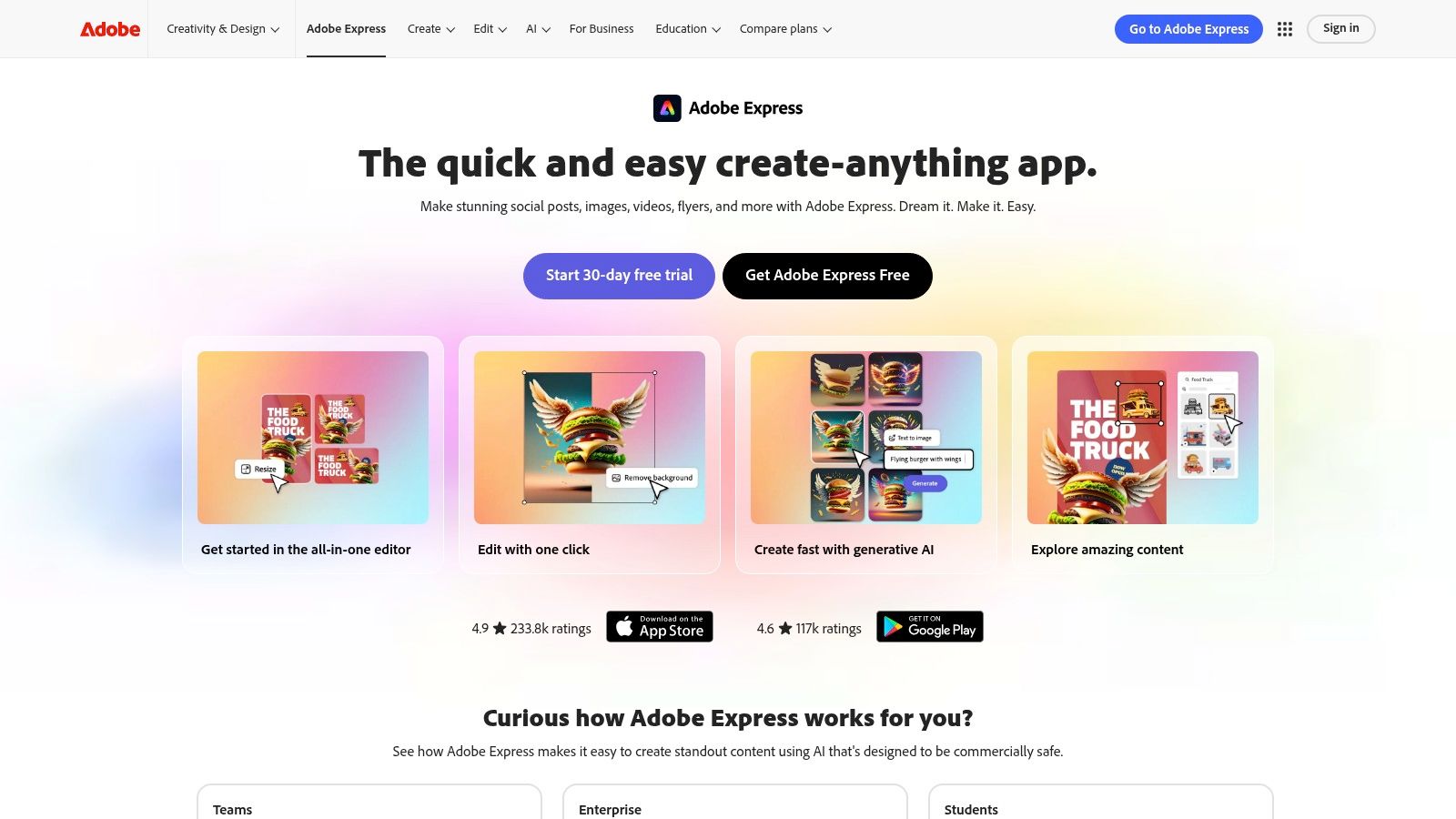
One of the key strengths of Adobe Express lies in its extensive collection of content creation templates. Whether you're crafting an Instagram post, a Facebook cover, a YouTube thumbnail, or even a short animated video, you'll find a template to suit your needs. These templates are not just visually appealing but also highly customizable. You can easily modify colors, fonts, images, and layouts to align with your brand identity and messaging. This saves you considerable time and effort, allowing you to focus on crafting compelling content rather than getting bogged down in design details.
The AI-powered features within Adobe Express further streamline the content creation process. Quick Actions, powered by Adobe Sensei, allow you to perform complex tasks with just a few clicks. For instance, you can instantly remove backgrounds from images, resize content for different platforms, or even animate static graphics. The AI-powered design suggestions offer intelligent recommendations for fonts, color palettes, and layouts, helping you create visually harmonious and engaging content.
Integration with Adobe Creative Cloud is a significant advantage for users already working within the Adobe ecosystem. You can seamlessly import and export assets between Adobe Express and applications like Photoshop, Illustrator, and Premiere Pro. This allows for a smooth workflow and greater creative control, particularly for projects requiring advanced editing or design capabilities. Access to the Adobe Stock library provides a wealth of high-quality images, videos, and graphics that you can incorporate into your content.
For individual creators and influencers, Adobe Express offers a simple yet powerful way to create professional-looking content for social media and other online platforms. Small business owners and entrepreneurs can leverage the platform to design marketing materials, website graphics, and social media posts, enhancing their brand presence and attracting customers. Digital marketing agencies can use Adobe Express to create engaging visuals for client campaigns, while social media managers can efficiently produce high-quality content for their social media channels. Developers and automation specialists can even integrate Adobe Express into their workflows through APIs, automating content creation tasks.
While Adobe Express offers numerous advantages, it's essential to consider its limitations. There is a learning curve, especially for users unfamiliar with the Adobe interface. Compared to some competitors, Adobe Express is more expensive, particularly if you require access to all features, which necessitates a subscription. The extensive feature set can feel overwhelming for users looking to create simple projects.
Adobe Express offers different pricing tiers. A free starter plan provides access to basic features and limited templates. Paid plans unlock more advanced features, templates, and access to the Adobe Stock library. Specific pricing details are available on the Adobe website. Technically, Adobe Express is a web-based application, meaning it works on any device with a modern web browser. There are also mobile apps available for iOS and Android devices.
To get started with Adobe Express, simply sign up for an account on the Adobe website (https://www.adobe.com/express/). Explore the vast library of content creation templates, experiment with the AI-powered features, and customize your chosen template to fit your specific needs. The platform offers tutorials and support resources to help you navigate the interface and make the most of its capabilities. Consider starting with a simple project to familiarize yourself with the tools and features before tackling more complex designs. By leveraging the power of Adobe Express, you can elevate your content creation game and produce visually stunning materials that capture attention and drive results.
3. Figma Templates
Figma has become a powerhouse for design, offering a vast library of community-driven templates that cater to a wide range of content creation needs. From polished presentations and engaging social media graphics to intricate website mockups and UI/UX designs, Figma provides a versatile platform for crafting high-quality visuals. Its collaborative features make it particularly attractive for teams working on content creation workflows. This rich feature set makes it a worthy contender in the realm of content creation templates.

One of Figma's greatest strengths lies in its community-generated template library. Designers worldwide contribute to this ever-growing repository, offering both free and premium content creation templates. This means you can often find pre-designed templates for everything from YouTube thumbnails and Instagram stories to infographics and website wireframes. This vast library allows creators to quickly jumpstart their projects, saving valuable time and effort that would otherwise be spent on building designs from scratch. For instance, a social media manager struggling to create visually appealing Instagram stories can explore pre-built templates, customize them with their brand colors and content, and publish them quickly, maintaining a consistent and professional online presence.
Figma’s vector-based design tools provide pixel-perfect precision, ensuring your content looks crisp and professional across various devices and platforms. The component system further enhances efficiency by allowing you to create reusable design elements. This means you can create a consistent brand identity across all your content by reusing logos, color palettes, and typography styles. Consider a small business owner creating marketing materials: they can create a component for their logo and easily insert it into every design, ensuring brand consistency across flyers, social media posts, and presentations. Learn more about Figma Templates to understand how this can streamline your workflow.
Real-time collaborative editing is another standout feature. Multiple users can simultaneously work on the same file, making it ideal for team projects and client collaborations. This streamlines feedback and revisions, significantly speeding up the content creation process. Imagine a marketing agency working on a client's presentation: the designer, copywriter, and project manager can all work together in real-time, ensuring everyone is on the same page and reducing back-and-forth communication. Figma's advanced prototyping capabilities further elevate the design process, enabling creators to simulate interactive user experiences for websites and apps. This allows for thorough user testing and refinement before the final product goes live.
While Figma boasts numerous advantages, it also has some limitations. The platform has a steeper learning curve compared to more basic design tools like Canva. While Figma offers a free plan, access to the full range of features, including unlimited cloud storage and collaborative projects, requires a paid subscription. The pricing varies depending on the team size and specific needs. Also, while Figma excels in digital design, it is primarily focused on that area and may not be the ideal choice for print-based content creation. Finally, while the community provides a wide array of templates, the number of marketing-specific content creation templates might be limited compared to platforms specifically catering to marketing needs.
Figma's strength lies in its versatility and professional-grade design capabilities. It caters to a broad audience, including individual creators, influencers, small business owners, digital marketing agencies, social media managers, developers, and automation specialists. While it might be overwhelming for absolute beginners, the investment in learning Figma can pay off significantly for those looking to create high-quality, professional content. The extensive template library, coupled with the powerful design and collaboration features, makes Figma a valuable tool for anyone involved in the content creation process. However, potential users should consider the learning curve and the internet dependency before fully committing to the platform.
4. Notion Templates
Notion has become a powerhouse for content creation, offering a robust suite of templates designed to streamline content planning, organization, and workflow management. From editorial calendars and content briefs to campaign planners and complex workflow systems, Notion provides a centralized platform for individuals and teams to manage their entire content lifecycle. This makes it an ideal choice for anyone looking to improve their content strategy and team collaboration. It deserves a spot on this list because of its flexibility, collaborative features, and the ability to tailor it to a wide variety of content needs, all while offering a generous free tier.
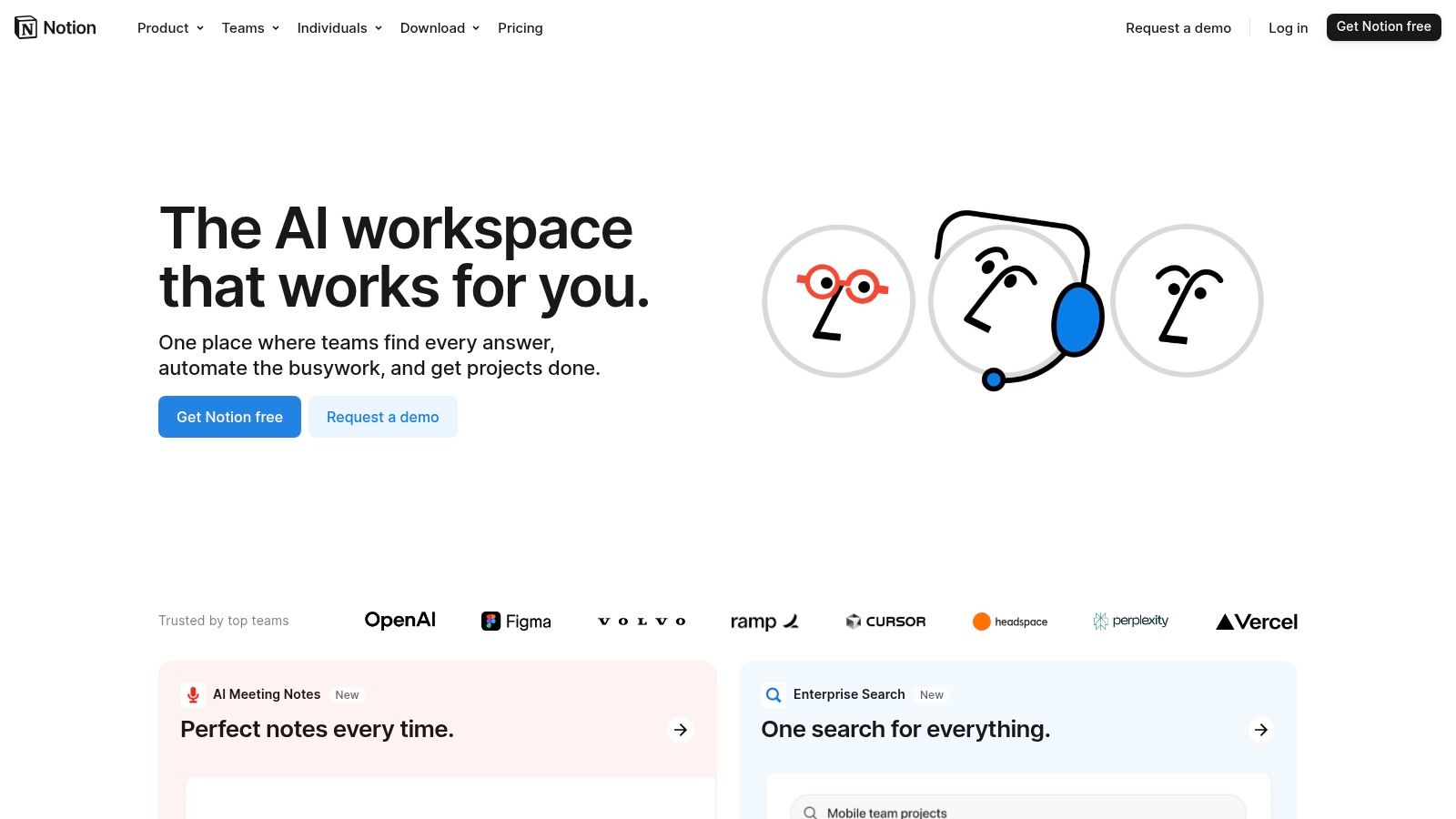
One of Notion's key strengths lies in its database-driven architecture. Content can be organized using customizable properties, tags, and filters, allowing users to create highly specific views of their content library. For example, a social media manager could create a content calendar database with properties for platform, content type, publishing date, and campaign, enabling them to easily filter and sort content for different campaigns or platforms. This level of organization is crucial for maintaining consistency and efficiency in content creation.
Notion also shines in its collaborative capabilities. Teams can work together on the same documents and databases in real-time, with features for assigning tasks, tracking progress, and providing feedback directly within the platform. This eliminates the need for endless email chains and scattered communication, fostering a more streamlined and collaborative workflow. Imagine a marketing team working on a blog post: the writer can draft the content, the editor can review and provide feedback, and the SEO specialist can optimize the article, all within the same Notion page.
For individual creators and influencers, Notion’s content calendar and editorial planning templates offer a way to organize ideas, schedule posts, and track performance. Small business owners and entrepreneurs can leverage Notion to manage their content marketing strategy, from brainstorming topics to tracking campaign results. Digital marketing agencies can utilize Notion to manage client projects, create content briefs, and collaborate with team members. Even developers and automation specialists can find value in Notion's API and integration capabilities, allowing them to connect their content workflows with other tools and automate tasks.
While Notion is incredibly powerful, it does have some drawbacks. The initial setup can feel overwhelming due to its flexibility and customization options. It's not a drag-and-drop design tool; its strength lies in planning and organization, not visual design. Users should anticipate spending some time learning the platform's features to unlock its full potential. If you're primarily looking for a visually-driven content creation tool, Notion might not be the best fit. However, if you're looking to build a robust content strategy and manage your workflow efficiently, the initial investment in learning Notion is well worth the effort.
Notion offers a generous free tier that is suitable for individual users and small teams. Paid plans unlock additional features like increased file uploads, version history, and collaborative features for larger teams. Pricing scales depending on the number of users and the features required. For detailed pricing information, refer to the official Notion website.
If you're looking to dive deeper into using Notion for content planning, especially for social media, I recommend checking out this guide: Learn more about Notion Templates. It offers valuable insights into setting up a social media content calendar in Notion.
To get started with Notion for content creation, explore their template gallery. You'll find pre-built templates for various content types, including blog posts, social media updates, video scripts, and more. These templates provide a solid foundation and can be customized to fit your specific needs. Don't be afraid to experiment with different templates and features to find what works best for your workflow. Notion’s flexibility is its greatest strength, empowering you to create a content creation system tailored to your specific requirements. Whether you are an individual creator or part of a large team, Notion offers the tools to manage your content creation process efficiently and effectively, making it a valuable asset for anyone working with content.
5. Visme
Visme is a robust visual content creation platform specializing in eye-catching presentations, infographics, reports, and social media graphics. It distinguishes itself through its focus on data visualization and interactive content, making it a powerful tool for creating engaging and informative content. While it might not boast the largest template library compared to some competitors, its strength lies in the quality and professional design of its templates, particularly for data-driven projects. This makes it a valuable asset for anyone looking to present information clearly and compellingly, from individual creators to large marketing agencies.
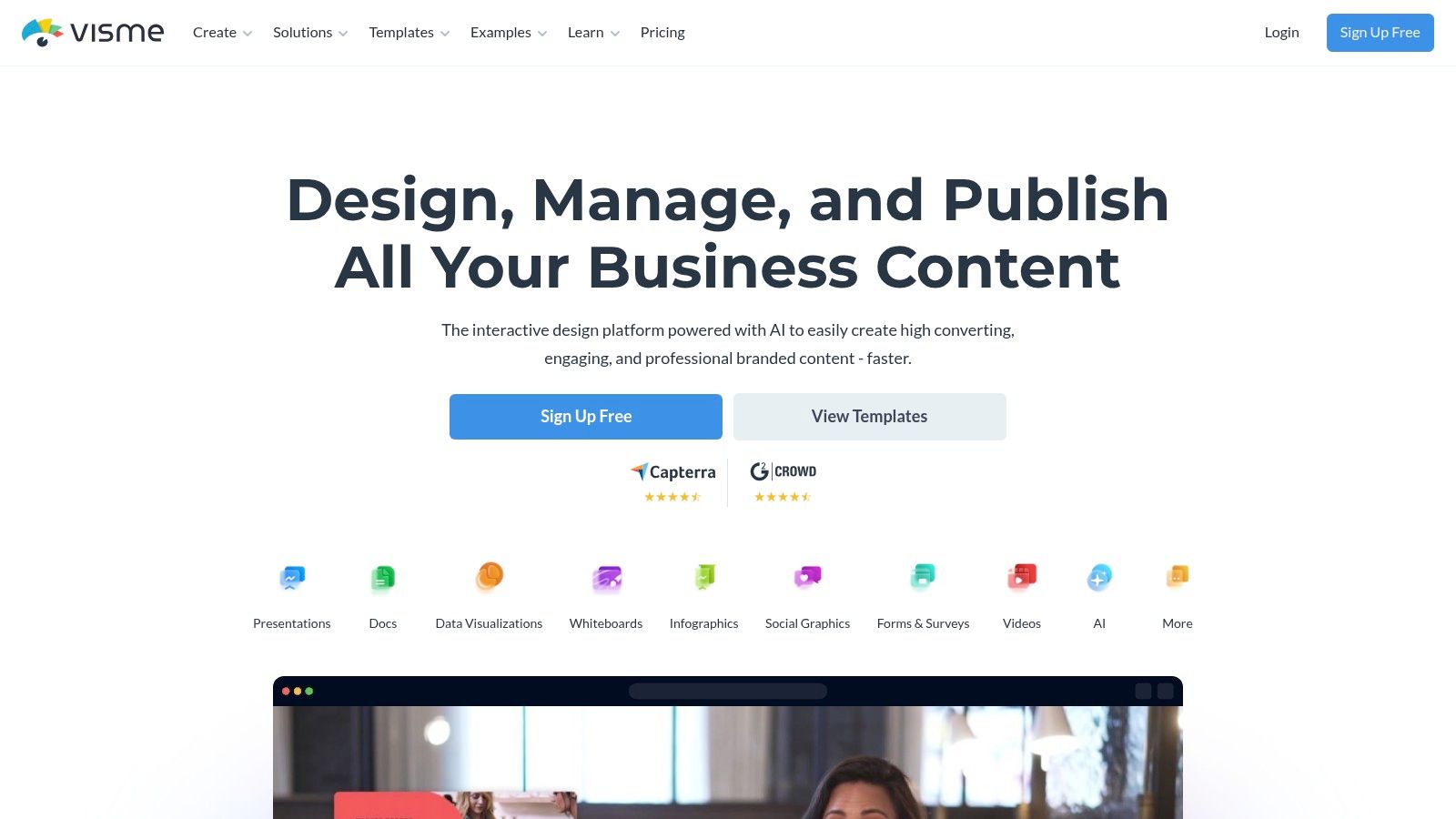
If you’re looking to create content that goes beyond static images and incorporates dynamic elements, Visme is worth exploring. Its interactive content capabilities allow you to add animations, transitions, and even quizzes to your projects, boosting audience engagement and knowledge retention. Imagine creating an infographic where users can click on different sections to reveal more detailed information, or a presentation that includes interactive polls to gauge audience understanding in real-time. These are just a few examples of how Visme’s interactive features can elevate your content.
One of Visme’s key strengths is its excellent data visualization tools. You can easily transform raw data into visually appealing charts, graphs, and maps, making complex information easier to digest and understand. This makes it an ideal choice for businesses, researchers, and educators who need to communicate data effectively. For example, marketing agencies can use Visme to create visually compelling reports showcasing campaign performance, while educators can design interactive infographics to explain complex concepts to students.
Visme also offers brand management and style guide tools, ensuring consistency across all your visual content. This is particularly beneficial for businesses and organizations that need to maintain a unified brand identity. You can define your brand colors, fonts, and logos within Visme, and these settings will be automatically applied to your projects. This streamlines the content creation process and ensures brand consistency across all your outputs.
While Visme shines in its data visualization and interactive features, it does have a few limitations. The template library, although containing high-quality designs, is smaller than some competitors like Canva. This might restrict users looking for a wider variety of pre-designed templates, particularly for simple social media graphics. Additionally, some of the advanced features, such as animation and interactivity, have a steeper learning curve. While basic usage is relatively straightforward, mastering these advanced features might require some time and effort.
Visme offers a limited free plan, but to unlock its full potential, you’ll need to subscribe to one of their paid plans. Pricing varies depending on the features and the number of projects you need. It's worth checking their website for the most up-to-date pricing information. If you're interested in improving your content strategy overall, you might want to Learn more about Visme and other content planning tools. This can give you a broader perspective on how Visme fits into a comprehensive content creation workflow.
For individual creators and influencers looking to create visually stunning data-driven content, Visme is a strong contender. Small business owners and entrepreneurs can benefit from its brand management tools and professional templates, while digital marketing agencies can leverage its data visualization capabilities to create compelling reports and presentations. Developers and automation specialists might find its interactive features useful for building engaging user experiences. However, if your primary focus is creating simple social media graphics, other tools with larger template libraries might be a better fit. Ultimately, the best way to determine if Visme is right for you is to take advantage of the free trial and explore its features firsthand.
6. Later Influence
Later Influence, a component of the Later social media management platform, offers a robust suite of content creation templates specifically designed for various social media platforms like Instagram, TikTok, Facebook, Pinterest, and Twitter. This tool goes beyond simple template provision by integrating scheduling, publishing, and analytics features, making it a comprehensive solution for social media content management. For content creators seeking to streamline their workflow and optimize their social media presence, Later Influence presents a compelling option. Its focus on platform-specific templates allows users to easily create engaging content that adheres to the best practices of each platform.
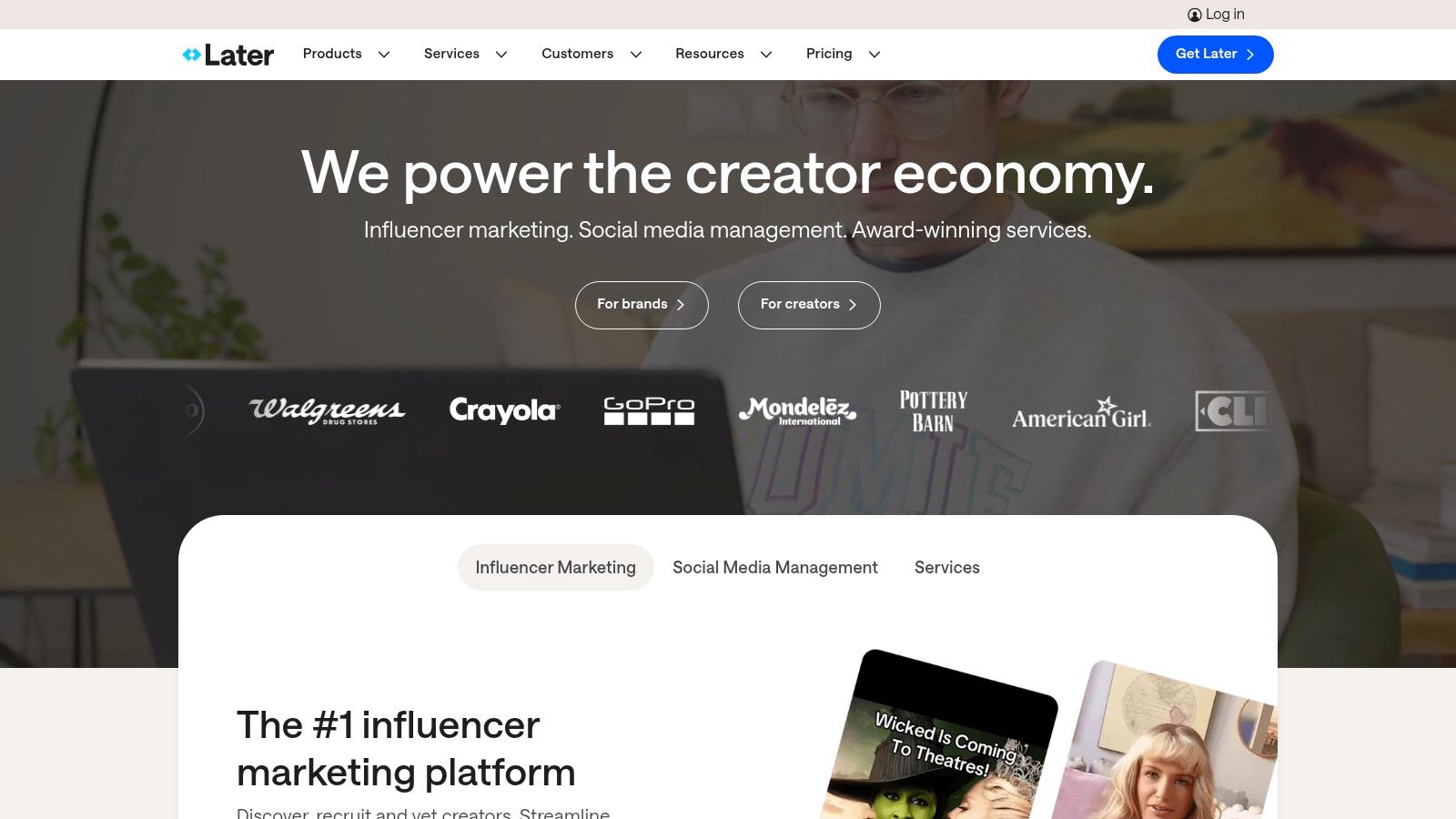
One of the key strengths of Later Influence lies in its specialization for social media content. It understands the nuances of different platforms and provides templates tailored to their specific requirements. Whether you're crafting a visually appealing Instagram post, a short-form TikTok video, or a text-based Twitter update, Later Influence has pre-designed templates to get you started. This focus on social media differentiates it from generic content creation templates, which might not be optimized for the specific needs of social platforms.
Furthermore, Later Influence's integrated scheduling and publishing features significantly streamline the content creation workflow. Once you've customized a template, you can schedule it for publication at your desired time, eliminating the need to switch between different tools. This integration saves time and allows for a more organized approach to social media management. The built-in content calendar visualization further enhances this organizational aspect by providing a clear overview of your scheduled posts across different platforms.
Later Influence also shines in its analytics capabilities. It provides performance analytics specifically related to your template usage, allowing you to understand which templates are resonating with your audience and driving engagement. This data-driven approach enables you to refine your content strategy and optimize your template selection for better results. You can track metrics such as likes, comments, shares, and clicks to gauge the effectiveness of your templates and identify areas for improvement. This analytics feedback loop is invaluable for continuous content optimization.
While Later Influence offers a powerful suite of features, it's essential to be aware of its limitations. The platform is primarily focused on social media content, so it might not be the ideal choice for creators working with other content types like blog posts or email newsletters. Also, while Later offers a free version, accessing the full range of features, including a wider selection of templates and advanced analytics, requires a paid subscription. The pricing varies based on the plan you choose, so it's important to evaluate your needs and budget before committing to a subscription. Finally, compared to some other content creation tools, Later Influence might offer fewer customization options, and some users may find the pre-designed templates lacking in uniqueness.
For individual creators and influencers, small business owners, and social media managers, Later Influence provides an efficient and user-friendly way to create engaging social media content. Its platform-specific templates, integrated scheduling, and performance analytics are valuable assets. Digital marketing agencies can also leverage Later Influence to manage multiple client accounts and streamline their social media workflows.
Implementation and Setup Tips:
- Start with a Free Trial: Explore the free version of Later to familiarize yourself with the interface and basic features before committing to a paid plan. This will help you determine if it meets your needs.
- Connect Your Social Media Accounts: Integrate your social media profiles to seamlessly schedule and publish content directly from Later Influence.
- Explore the Template Library: Browse the available templates for different platforms and choose those that align with your brand and content strategy.
- Customize Templates: Tailor the chosen templates with your own images, text, and branding elements to create unique and engaging content.
- Utilize the Content Calendar: Plan your social media posts in advance using the content calendar feature to maintain a consistent posting schedule.
- Track Your Analytics: Monitor the performance of your content and use the analytics data to refine your template selection and overall content strategy.
Later Influence earns its spot on this list by providing a targeted solution for social media content creation. Its integrated features, platform-specific templates, and performance analytics offer a valuable combination for streamlining social media management and maximizing content impact. However, consider the limitations regarding content type specialization, subscription requirements, and customization options before making a decision. You can explore Later Influence and its features further by visiting their website at https://later.com.
7. Crello (now VistaCreate)
VistaCreate, formerly known as Crello, has carved a niche for itself in the crowded content creation template landscape by focusing on providing high-quality, easily customizable templates, particularly for animated content. This platform empowers users of all skill levels, from individual creators to marketing agencies, to produce engaging visuals for social media, marketing campaigns, and various other business needs. Its intuitive interface combined with a robust library of both static and animated templates makes it a strong contender for anyone looking to streamline their content creation process. Whether you're a seasoned designer or just starting out, VistaCreate offers a compelling blend of simplicity and professional-grade features. It deserves its place on this list due to its focus on animation, ease of use, and diverse template offerings, making content creation accessible and efficient.

One of VistaCreate's key strengths lies in its extensive library of animated templates. While many content creation platforms offer basic static templates, VistaCreate goes further by providing a wide array of dynamic, eye-catching animated options. This is particularly valuable in today's social media landscape, where movement and animation are crucial for capturing attention and boosting engagement. Users can easily customize these templates with their own branding, text, and images, making it simple to create professional-looking animated graphics, videos, and social media stories in minutes. This feature is a game-changer for small business owners, influencers, and social media managers who want to elevate their content without needing advanced design skills or expensive software.
Beyond animations, VistaCreate also offers a robust collection of static templates for various content formats, including social media posts, ads, presentations, posters, and more. The platform intelligently optimizes templates for different social media platforms, ensuring your visuals are perfectly sized and formatted for each channel. This saves valuable time and effort, allowing users to focus on the creative aspects of their content rather than technical specifications.
VistaCreate also provides helpful tools for maintaining brand consistency. Users can create a Brand Kit to store their logos, fonts, and color palettes, making it easy to apply their branding across all their designs. This is especially useful for businesses and agencies managing multiple brands or campaigns. Further enhancing its editing capabilities, VistaCreate includes a background remover and photo editing tools, allowing for greater flexibility and customization directly within the platform.
While VistaCreate boasts a user-friendly interface, even beginners can quickly navigate the platform and start creating content within minutes. The drag-and-drop editor makes customization a breeze, and the platform offers a range of pre-designed elements, such as icons, illustrations, and stock photos, to enhance your designs. This streamlined workflow significantly reduces the learning curve, making it accessible to users with limited design experience.
In terms of pricing, VistaCreate offers a free plan with access to a limited library of templates and features. The Pro plan unlocks the full template library, removes watermarks, and provides access to premium features like the Brand Kit. While the Pro plan requires a subscription, it is competitively priced compared to similar tools on the market, making it a cost-effective option for businesses and individuals looking for professional-grade content creation capabilities.
However, it’s important to acknowledge some limitations. While VistaCreate excels in ease of use and animation, it does have a smaller community and fewer integrations compared to industry giants like Canva. Advanced design features are also limited, and some templates require a premium subscription.
For implementation, simply visit the VistaCreate website (https://create.vista.com) and sign up for an account. The platform is entirely web-based, so there are no software downloads or technical requirements. Once you've created your account, you can immediately start browsing the template library and creating your own content. Whether you need to create an engaging Instagram story, a professional Facebook ad, or an eye-catching presentation, VistaCreate offers a powerful yet accessible solution for producing high-quality content quickly and efficiently. Its focus on animation, user-friendly interface, and diverse template options make it a valuable tool for content creators of all levels.
8. Piktochart: Visual Storytelling for Data-Driven Content
When it comes to transforming complex data into engaging visuals, Piktochart stands out as a powerful content creation template tool. Specifically designed for creating infographics and reports, Piktochart empowers users to communicate information effectively and captivate their audience with compelling visual narratives. If your content strategy relies heavily on data visualization, educational materials, or professional business reports, Piktochart deserves serious consideration. This platform offers a streamlined process for creating polished, visually appealing content that transcends the limitations of plain text and static presentations. It earns its place on this list by offering a specialized solution for a specific content need, filling the gap for those looking to go beyond basic social media graphics and delve into richer, more informative visual content.
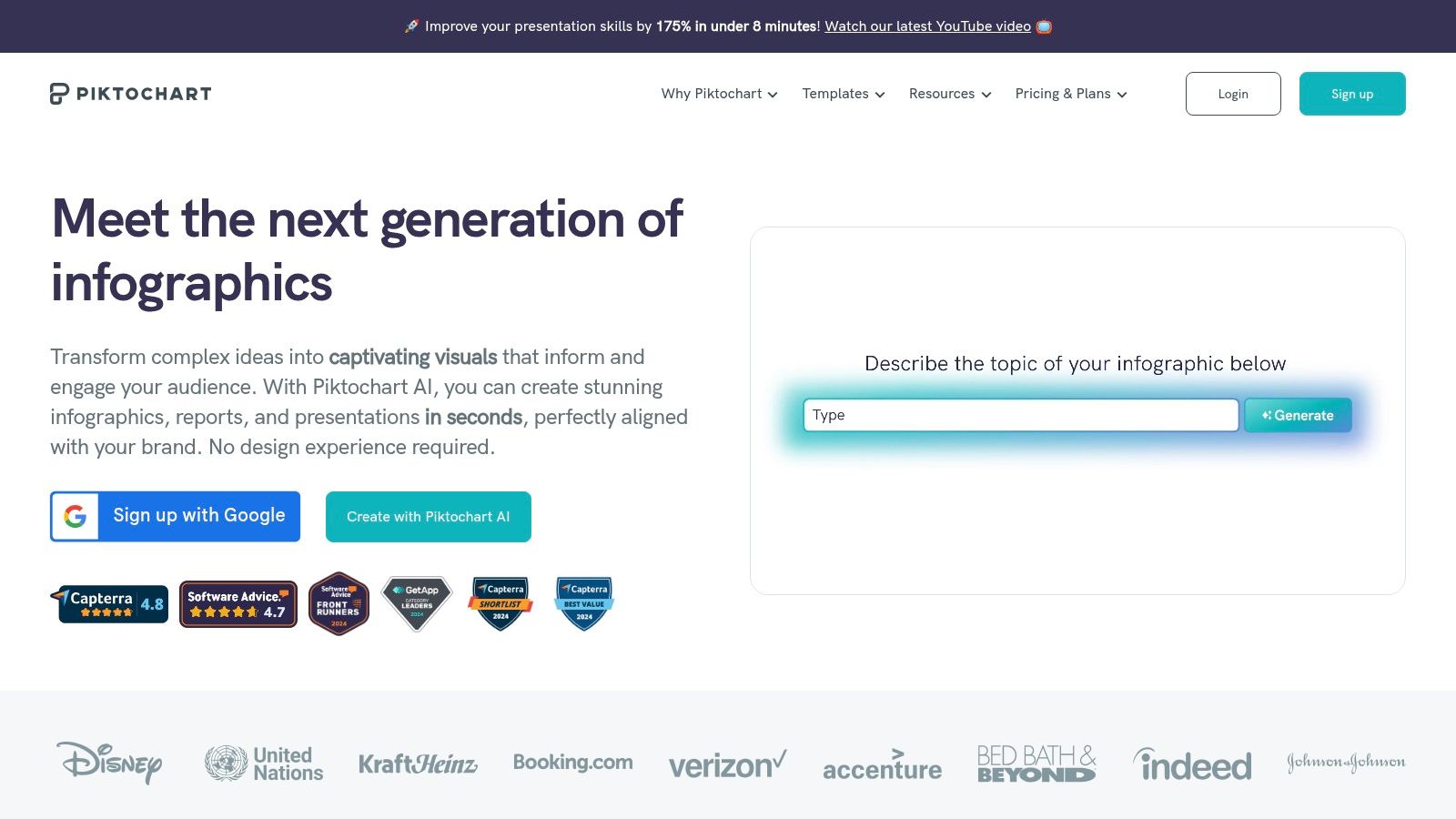
Piktochart's strength lies in its specialized infographic and report templates. Whether you're a seasoned designer or a complete novice, you can leverage these pre-designed templates as a starting point and customize them to fit your specific needs. These content creation templates provide a structured framework, allowing you to easily input your data and watch it transform into a visually compelling narrative. Think of creating a market research report, summarizing survey results, or presenting complex financial data – Piktochart makes these tasks significantly easier and more visually impactful.
One of the standout features of Piktochart is its seamless data integration and visualization tools. You can directly import data from spreadsheets and other sources, eliminating the need for manual entry and reducing the risk of errors. The platform then provides a variety of chart types, graphs, and visual representations to showcase your data in the most effective way. From bar charts and pie charts to more complex visualizations like treemaps and network diagrams, Piktochart gives you the flexibility to tailor your visuals to the specific data you're presenting. Furthermore, some templates even offer interactive infographic capabilities, allowing users to explore the data at their own pace and uncover deeper insights. This interactivity elevates the content beyond static visuals, creating a more engaging experience for the audience.
Collaboration is key in many content creation workflows, and Piktochart recognizes this by offering robust team collaboration and sharing features. Multiple users can work on the same project simultaneously, streamlining the editing and approval process. This is particularly valuable for agencies and larger teams, ensuring everyone stays on the same page and contributing efficiently. Additionally, white-label options are available for agencies, enabling them to customize the platform with their own branding and deliver a seamless client experience.
While Piktochart excels in its niche, it's essential to be aware of its limitations. The platform is primarily focused on infographics and reports, making it less suitable for creating general social media content or other diverse content formats. While it offers a free version, accessing the full range of advanced features requires a paid subscription. The pricing tiers vary based on the features and the number of users, so it's crucial to evaluate your needs and budget before committing to a plan. Lastly, while the platform aims for user-friendliness, there can be a slightly steeper learning curve for beginners compared to more basic graphic design tools. However, the platform provides ample resources and tutorials to help users get up to speed quickly.
Comparing Piktochart to Similar Tools:
Tools like Canva and Visme also offer infographic creation capabilities, but Piktochart distinguishes itself with its focus on data visualization and reporting. Canva is a more general-purpose design tool, while Visme sits somewhere in between Canva and Piktochart in terms of specialization. If your primary need is data-heavy infographics and reports, Piktochart's specialized features give it an edge.
Implementation Tips:
- Start with a Template: Leverage the existing templates to jumpstart your design process.
- Data Integration: Utilize the data import features to streamline your workflow.
- Brand Consistency: Ensure your infographics align with your brand guidelines.
- Interactivity (When Appropriate): Consider using interactive elements to enhance engagement.
For creators dealing with complex data and looking to transform it into compelling visuals, Piktochart is a valuable addition to your content creation toolkit. Its specialized features, data integration capabilities, and professional-quality templates empower you to create visually stunning infographics and reports that communicate information effectively and leave a lasting impression. Visit their website (https://piktochart.com) to explore their offerings and see how Piktochart can elevate your content creation strategy.
Content Creation Templates Comparison
| Platform | Core Features ✨ | User Experience ★★★★☆ | Value Proposition 💰 | Target Audience 👥 | Unique Selling Points 🏆 |
|---|---|---|---|---|---|
| Canva | Drag-drop editor, 250K+ templates, video & animation | User-friendly, multi-platform, real-time collaboration | Free tier + premium plans 💰💰 | Beginners, marketers, creators | Extensive free templates, brand kit |
| Adobe Express | Pro templates, AI design suggestions, Adobe CC integration | High-quality, advanced tools, steeper learning curve | Premium subscription 💰💰💰 | Designers, pros, Adobe users | Adobe Stock access, advanced typography |
| Figma Templates | Community templates, vector tools, real-time collaboration | Professional, collaborative, requires design know-how | Mostly free with premium content 💰 | UI/UX designers, teams | Prototyping & reusable components |
| Notion Templates | Content calendars, workflow management, team collaboration | Highly customizable, planning-focused, some complexity | Free tier + paid plans 💰 | Content strategists, teams | Database-driven planning, deep customization |
| Visme | Infographics, data viz, interactive content, analytics | Professional but steeper learning curve | Limited free, higher tiers 💰💰 | Data storytellers, marketers | Interactive & analytic content |
| Later Influence | Social media templates, integrated scheduling & analytics | Specialized for social, easy scheduling | Subscription required 💰💰 | Social media managers, influencers | Platform-optimized templates, analytics |
| VistaCreate | Animated/static templates, video, brand kits | User-friendly, balanced ease & quality | Competitive pricing 💰💰 | Small businesses, marketers | Strong animation library |
| Piktochart | Infographics, reports, data import, team features | Professional, data-heavy, steeper learning curve | Higher cost for advanced features 💰💰 | Educators, businesses, agencies | White-label options, data integration |
Level Up Your Content Strategy
Content creation templates are essential for anyone looking to streamline their content creation process. From visually appealing graphics created with tools like Canva, Adobe Express, Visme, Crello (now VistaCreate), and Piktochart, to engaging social media posts planned using Later Influence, and organized workflows within Notion and Figma templates, the right template can significantly elevate your content game. This article has explored a range of powerful tools, each with its own strengths, allowing you to choose the best fit for your specific needs. Whether you're a solopreneur, a small business owner, a social media manager, or a seasoned developer, incorporating these tools into your workflow can free up valuable time and resources.
Key takeaways include the importance of selecting a tool that aligns with your existing workflow and the power of maintaining brand consistency through templated designs. Remember to consider factors like ease of use, customization options, and integration capabilities when making your decision. For even more advanced content creation options, explore the power of AI. Tools like AI ad generators can help streamline workflows and boost your marketing efforts.
By strategically leveraging content creation templates, you can shift your focus from tedious formatting to crafting compelling narratives and engaging with your audience. Experiment, discover what works best for you, and watch your content strategy flourish. Want to explore even more content creation possibilities? Discover Publora, a platform that simplifies content planning, creation, and publishing. Visit Publora and unlock a world of content creation potential.
